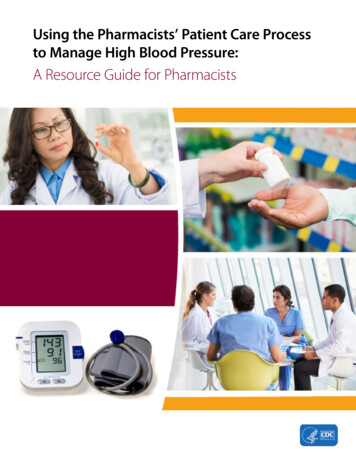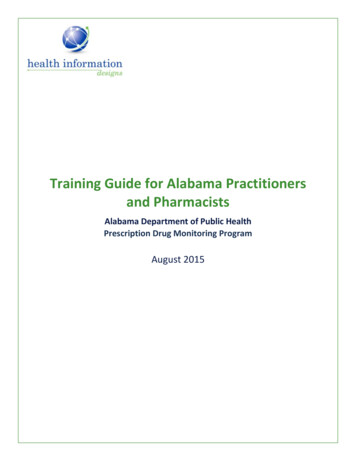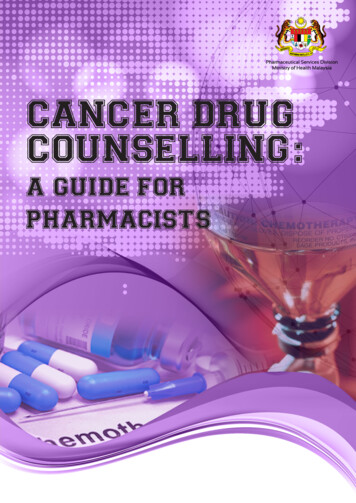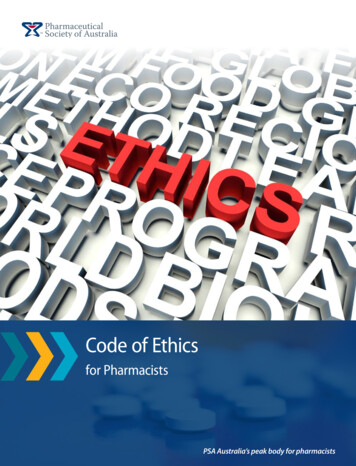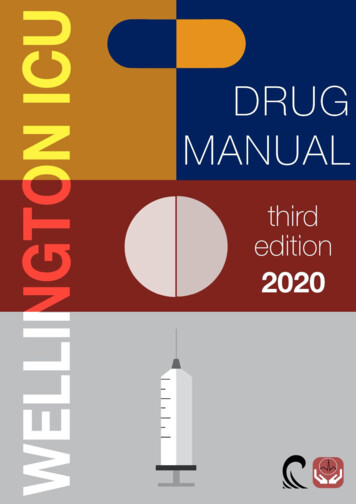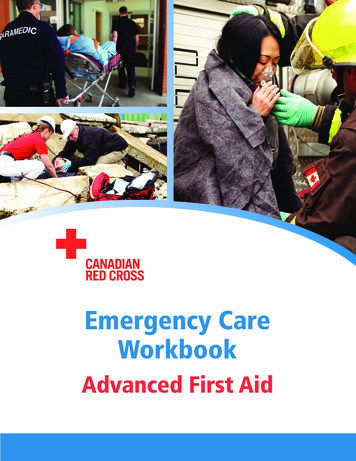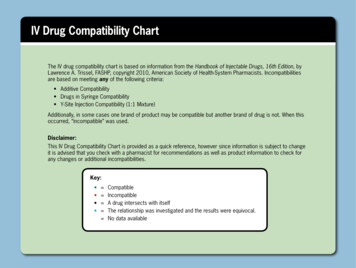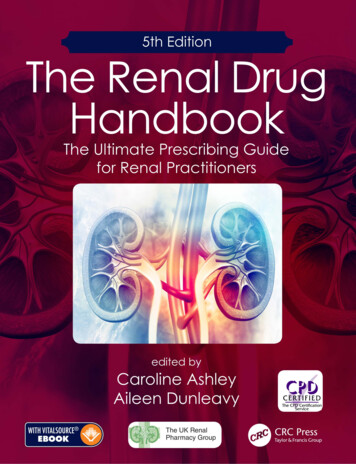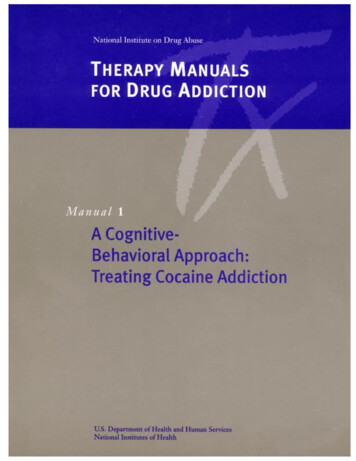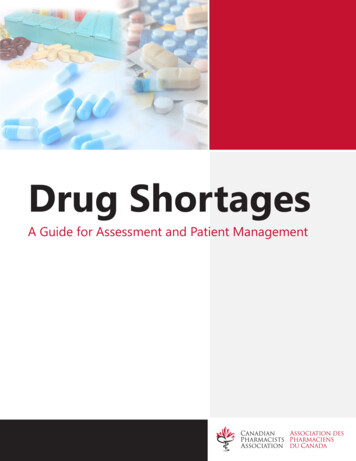
Transcription
Drug ShortagesA Guide for Assessment and Patient Management
Table of ContentsIntroduction . . . . . . . . . . . . . . . . . . . . . . . .2Managing Drug Shortages . . . . . . . . . . .3Step 1. Checking all medication supplyavenues . . . . . . . . . . . . . . . . . . . . . . . . . . .3Step 2. Determining how critical amedication is for a patient . . . . . . . . . . . .4Step 3. Selecting an alternativemedication . . . . . . . . . . . . . . . . . . . . . . . .7Step 4. Initiating a new therapy with analternative medication or discontinuingtherapy temporarily . . . . . . . . . . . . . . . . .9Communication between Pharmacists,Prescribers and Patients . . . . . . . . . . . . . .10References . . . . . . . . . . . . . . . . . . . . . . . . . .11PurposeIt is well known that drug shortages are not uncommon and, in fact,often occur as a part of the routine day for pharmacists.1,2,3 Thisguide presents a systematic approach to assess the impact of drugunavailability and subsequent patient management. It can be appliedwhenever drug shortages are encountered.This guide is a concise, practical tool for physicians, pharmacists and otherprescribers that can be used in any drug shortage situation. The guide wasdesigned to: P resent an explicit systematic process to use when faced with a drugshortage. H ighlight the unique position of pharmacists, physicians and otherprescribers in delivering a strong, reassuring and consistent message tothe public regarding the management of drug therapy in the face of drugavailability difficulties. D iscourage practices of stockpiling or having medications on hand“just‑in-case”, and to provide tips for communicating with patients.IntroductionMedication therapy is critical in treating and preventing diseaseand is an integral part of everyday life for many Canadians. Thepharmaceutical supply chain of manufacturers, wholesalers,distributors and pharmacists, as well as physicians andgovernments, acknowledge the importance of having a continuoussupply of medications.However, it is possible within today’s drug distribution system forglitches to occur, such as short-term back orders or long-termdrug unavailability. The challenge for health care providers is toprovide seamless, equivalent drug therapy at comparable costs.Assessment requires a critical evaluation of the current situationand potential impact of the shortage on patient outcomes.4When an important drug product is not available, practitioners willwant to know: reasons for the product’s unavailability when the product will be available options for obtaining the drug from alternate sources alternate therapies and their cost consequences related information needs of health care providers and patients.Disruptions in the supply of pharmaceuticals may occur due toseveral reasons, including: Unexpected increases in utilization of a drug, resulting ina temporary shortage until manufacturing capacity meetsdemand. Voluntary discontinuation or recalls of a product by amanufacturer. In some situations, other manufacturers marketthe same drug, but are unaware of the discontinuation, andtherefore do not adjust their manufacturing capacity in advance. Withdrawal from the market by Health Canada/manufacturer. Natural disasters (e.g., ice storms and floods). Increased demand due to emergency situations (e.g., masscasualties) or infectious disease outbreaks (e.g., caused by apandemic influenza).2Drug Shortages It is important to acknowledge there may be public concern thatCanadians will be without essential medicines.As front line health care providers, pharmacists, physicians andother prescribers are in a unique position to deliver a reassuringand consistent message to the public, as well as manage anychanges to drug regimens required due to a drug shortage. It alsoprovides an opportunity to do a full medication assessment orreview to determine overall appropriateness of drug therapy. CPhAhas developed this guide to assist in managing patients in theevent of a drug shortage.For drug-specific therapeutic information, pharmacists, physiciansand other prescribers are encouraged to refer to drug andtherapeutic references (e.g., Therapeutic Choices5; CPS6;eTherapeutics7), clinical practice guidelines (e.g., Canadian MedicalAssociation’s CPG Infobase at www.cma.ca/cpgs), or contact aregional drug information centre.If, in your practice, you are aware of critical drug shortagesthat necessitate changes to a patient’s drug therapy, and havedeveloped a unique way of managing the situation, please shareyour experience with us. Please call 1-800-917-9489, or email us atinfo@pharmacists.ca.CPhA will continue to monitor drug supply issues.Pharmacists, physicians and other prescribers must usetheir professional judgement in using this guide to meetthe needs of their own practice settings and situations, andto comply with applicable policies and regulations.This document has been revised from a guide on drugshortages first published by the Canadian PharmacistsAssociation in 1999, and updated in 2001. Canadian Pharmacists Association 2010
Managing Drug ShortagesAs a general overview of how drug shortages should be resolved,an algorithm (Figure 1) simplifies the management of drugshortages into a number of basic steps and questions.Pharmacists may find that the contents of this section representsteps that they have already internalized and practice on aday‑to‑day basis.The shaded boxes represent the three main steps to resolve amedication shortage:1. Exhausting every avenue to supply the medication2. Assessing how critical the drug is for the patientStep 1.Checking all medication supply avenuesDrug shortages are a day to day reality for pharmacists. If amedication is unavailable, the pharmacist investigates differentsources for obtaining the medication. Use the following checklistto double check and document the process for obtaining andsupplying medications.Figure 2. Checklist for medication supply avenues1. Is the medication interchangeable with any brand nameor generic alternatives?h Yes h No3. Selecting an alternative medication, if required.Figure 1. Suggested approach for pharmacists in themanagement of a drug shortage2. If the medication is available in other dosage strengths,can the dose be made up using other strengths?h Yes h No3. If the medication is available in a different formulation,can the drug be supplied in this form? Are thereany bioavailability differences which require dosageadjustment?Drug shortage encounteredHave I exhausted every avenue to supply the drug?h Yes h No4. Can drug supply be obtained through anotherpharmacy?NOYESConsult checklistfor different supplyavenues (Figure 2)Is this a critical drug?(Figure 3)h Yes h No5. Can drug supply be obtained through your regularwholesaler or other wholesalers?h Yes h NoNOYESDiscuss drugshortage withpatient andprescriber*Select an appropriatealternative on anindividual patient basis(Figures 4 and 5)Discuss drug shortageand alternative drugwith patient andprescriber** In many provinces, pharmacists are authorized to adapta prescription or prescribe an alternative dosage form ormedication. Canadian Pharmacists Association 2010 6. Can drug supply be obtained directly from themanufacturer?h Yes h NoNotesDrug Shortages3
Step 2.Determining how critical a medication is for a patientIf a medication is unobtainable and cannot be supplied to a patient,the pharmacist and prescriber must work together to determinehow essential or “critical” the drug is so that the appropriate courseof action can be determined. The potential consequences of drugunavailability must be carefully considered for each individual case.A drug shortage also provides an opportunity to do a fullmedication assessment or review to determine the overallappropriateness of drug therapy. Use the following series ofquestions to assess the impact of a drug shortage on a patient, andto document the process undertaken with the patient.Table 1 and Figure 3 will assist the health care practitioner indetermining how critical a medication is: Level 1 drugs: critical drugs that cannot be missed for even asingle dose or day Level 2 drugs: critical drugs that may be missed for greaterthan one dose or day, but should be reinstituted as soon aspossible since they reduce long-term complications of diseaseand reduce intolerable symptoms of disease Level 3 drugs: non-critical drugs that can safely be withheld fora period of timeTable 1: Classification of critical and noncritical drugs and recommended actionsDescriptionLevel 1Level 2Level 3CRITICAL DRUGDrug should be available forinitiation or continuation.CRITICAL DRUGDrug should be available forinitiation or continuation.NON-CRITICAL DRUGDrug availability is preferredbut not crucial.Drug therapy for diseaseis essential and cannot beinterrupted for even one dose orone day.Drug therapy for disease isimportant; however therapy maybe interrupted for greater thanone dose or one day, but shouldnot be interrupted for extendedduration.Drug therapy is valuable, yetmay be interrupted for anextended durationof time.Drug actions may: be acutely life saving* (e.g.,nitroglycerin for angina attack) reduce debilitating symptoms ofdisease or patient morbidity (e.g.,opioids for cancer pain) precipitate dangerous disease eventswith cessation (e.g., insulin products)Drug actions may: be life-saving over time(e.g., diuretics for hypertension) reduce intolerable symptoms ofdisease or patient morbidity*Medications that are not firstline therapies andwhose actions are accomplished by alternatetherapies are exceptions.Drug use may: be based on patient preferenceonly reduce minor symptomsof disease (e.g., H2 receptorantagonists for dyspepsia) be mostly adjunctive(e.g., montelukast in asthma) add minimal benefit tomanagement of disease be lifestyle drugs (e.g., finasteridefor male pattern baldness)Action 1 Use interchangeable product ifmedication is unavailable. For singlesource products, go to Action 2.Use interchangeable product ifmedication is unavailable.Use interchangeable product ifmedication is unavailable.Action 2 Switch to an alternative drug withinclass, if class effect exists.Consult with prescriber.May consider a switch to analternative drug within class, if classeffect exists.Consult with prescriber.Switching to an alternative drugwithin class may not be required.Discuss with patient and prescriber.Action 3 Switch to alternate drug class to ensurecontinued therapy for disease.Discuss with patient. Consult withprescriber.Substitution with alternate drug classmay not be required.Discuss with patient and consultprescriber.Contact patient as soon asmedication becomes available.Substitution with alternate drugclass is not required.Discuss with patient and prescriber.Inform patient when medicationbecomes available. In many provinces, pharmacists are authorized to adapt a prescription or prescribe an alternative dosage form or medication.Note: This classification system should be used as a guide only. Professional judgement is required in determining whether the above classification of a particular drug isappropriate for each patient, based on individual patient need and assessment.4Drug Shortages Canadian Pharmacists Association 2010
Figure 3. Steps to determine how critical a medication is for a patient1. What is the seriousness of the disease?For what disease/condition is the drug being used?3. How essential is the medication in the management ofthe disease and what are its therapeutic benefits?What are the consequences of untreated disease?h Acutely life-saving (e.g., nitroglycerin in unstable angina)h Acutely life-threatening (e.g., angina attack)h Cures disease (e.g., antibiotics for community acquiredpneumonia)h Causes debilitating symptoms leading to decreased qualityof life (e.g., cancer related pain)h Causes bothersome symptoms with no long-termconsequences (e.g., allergic rhinitis)h Prevents onset/progression of long-term consequences(e.g., HMG CoA reductase inhibitors for cardiovasculardisease)h Serious long-term consequences but not currentlybothersome (e.g., hypertension)h Reduces/controls bothersome symptoms of disease(e.g., sumatriptan, a 5HT1 agonist for migraine)NotesNotes2. What is the effect of abrupt withdrawal of themedication on the patient?4. Is the patient currently deriving the benefits of themedication?On the disease?On other medications being taken by the patient?h Is the medication known to be associated with a withdrawalreaction? (e.g., beta-blockers, SSRIs, anticholinergics)h Will abrupt drug withdrawal precipitate a complication ofthe disease? (e.g., nitroglycerin for angina)h Had the patient’s medications been adjusted to compensatefor drug interactions? Will abrupt withdrawal result in theappearance of any drug interactions? (e.g., warfarin druginteractions)Notesh Is the treatment working? Objective data (e.g., lipid profile)h Is the treatment working? Subjective data. What is thepatient’s perceived efficacy of the medication? (e.g., PPIs forGERD symptoms)h Is the medication meeting the patient’s goals?(e.g., Analgesics may reduce but not completely eliminatepain in patients with cancer pain. Pain reduction maybe an acceptable goal for the patient rather than painelimination.)h Is the patient experiencing any adverse effects fromtherapy?h Is the patient adherent with drug therapy?h Is the drug therapy still required?Notes Canadian Pharmacists Association 2010 Drug Shortages5
Figure 3. Steps to determine how critical a medication is for a patient – continued5. For how long is the duration of the expected drugshortage? Will the drug be unavailable for:7. For what length of time can the medication be missedwithout serious detriment to the patient? (See Table 1)h one dayh Not even a single dose or dayh a few daysh Greater than one dose or one dayh several weeksh Extended duration of time (several weeks)h unknownNotesNotes6. What patient factors may increase or decrease theimpact of the drug shortage on the patient?h Is the patient anxious about the unavailability of his/hermedication?8. Based on the above considerations, how critical is themedication in this situation? (See Table 1)h Level 1 critical drugh Level 2 critical drugh Level 3 non-critical drugh Could this encourage patient non-adherence?h Could this result in the patient perceiving the therapy as notimportant?NotesNotesThe final step in the process is for the physician, pharmacist or other prescriber to integrate all the available information to arrive ata rating of how critical the unavailable medication is to the patient. Classifying medications in this manner makes the prioritization ofmedications more explicit and helps to determine when a substitute medication must be chosen for the patient, or when a temporaryshortage of a medication may be acceptable. Table 1 can be used to grade how critical a certain drug may be and suggests actionsbased on the level of criticalness.6Drug Shortages Canadian Pharmacists Association 2010
Step 3.Selecting an alternative medicationIf a drug is critical for a particular patient, select a substitute that will be effective and tolerable therapy for the patient. Figure 4 describesthe factors that should be considered in selecting a substitute medication for a patient.Figure 4. Checklist for selecting an alternative medication1. Are there acceptable brand name or generic equivalentsavailable?h Yes h NoNotes4. How well does each alternate drug therapy work?h Does it provide similar efficacy in managing symptoms?(e.g., PPIs are superior to H2 receptor antagonists for severesymptoms of GERD.)h Does it have similar efficacy in improving outcomes ofdisease? (e.g., Digoxin does not reduce overall mortality ofheart failure as ACE inhibitors do.)h Has the patient tried any of these alternatives in the past?h How well did they work?2. Does the medication belong to a drug category that isknown to have a class effect?(e.g., ACE inhibitors, HMG CoA reductase inhibitors)Notesh Yes h NoNotes3. Are there any alternate drug therapies that may beconsidered? (Refer to current therapeutic references for possiblealternatives)5. When can the alternate drug therapy be expected tobegin working?( i.e., The ideal alternate therapy would begin to work as theeffects from the original drug wear off.)Notesh Yes h NoNotes Canadian Pharmacists Association 2010 Drug Shortages7
Figure 4. Checklist for selecting an alternative medication – continued6. What side effects or toxicities may be expected?h What are the short-term and long-term toxicities?h Do the therapeutic benefits of a medication outweigh itsassociated toxicities?h If used previously, did the patient experience any sideeffects or toxicities?Notes9. What other medications is the patient taking?h Do any of these medications interact with potentialalternate therapies?h Can dose modifications be made to overcome these druginteractions?Notes10. Is the alternate drug therapy easily administered?7. Does the patient have any other medical conditions,co‑morbidities or contraindications to the alternatedrug? (e.g., beta-blockers for asthmatics)Notes8. Are there any patient-specific factors that may modifyyour selection of a substitute drug therapy?h Does the patient have any drug allergies?h Is the patient pregnant or breastfeeding?h Does the age of the patient predispose him/her to certainadverse medication effects?h Is this patient unable to metabolize and/or eliminate thisdrug? (e.g., ACE inhibitors or digoxin in patients withreduced renal function)Notesh Can this medication be easily integrated into the patient’sroutine?h Is the patient capable of undertaking a new regimen?Notes11. Are the alternate drug therapies affordable for thepatient?h Is the medication covered by the patient’s drug plan?h Due to the shortage, is the alternate medication on specialauthorization?h Is it more expensive for the patient?Notes8Drug Shortages Canadian Pharmacists Association 2010
Step 4.Initiating a new therapy with an alternative medication or discontinuing therapytemporarilyFigure 5. Checklist for initiating a new therapy or discontinuing therapy1. What considerations need to be addressed whendiscontinuing the original medication?h Does the medication need to be tapered downward? If so,by how much and how often should the medication betapered? (e.g., steroid tapering)h What parameters should be monitored to ensure minimaladverse effects from drug termination? (e.g., beta-blockerwithdrawal: monitor heart rate, blood pressure, anginasymptoms, etc.)h What parameters should be monitored to ensure thatthe patient is not experiencing any unnecessary ill effectsrelated to loss of drug action on disease? (e.g., diuretics forheart failure stopped: monitor weight, edema, shortness ofbreath, etc.)Notes3. What considerations need to be addressed when thesubstitute medication is initiated?h Does the substitute medication need to be titrated upward?If so, by how much and how often should the medicationbe titrated? (e.g., carbamazepine initiation)h What parameters should be monitored to assess onset ofdrug action and adequacy of drug efficacy?h What parameters should be monitored to detect anyadverse effects related to the medication or fast titration ofmedication?h Is the drug covered by the patient’s drug plan? If not, isthere a special authorization process to allow for its use?Notes4. What are the treatment goals?2. Should the two therapies be overlapped during theswitchover?h Include patient in determining if treatment goals have beenmet.h When should the alternate therapy be initiated to providecontinuous drug coverage?Notesh How frequently should the new medication be given toensure continuous drug coverage? (e.g., fentanyl patchswitch to oral morphine tablets)Notes5. Does the patient require assistance to undertake a newregimen?h What is the patient’s comfort level with the new therapy?h What friend or family supports are needed to ensure asmooth transition from original medication to alternative?Notes Canadian Pharmacists Association 2010 Drug Shortages9
Figure 6. Choice of therapy when the original medication becomes available again1. Should the patient remain on the current medication orswitch back to the original?2. If the patient is to return to the original medication,what factors should be considered?h Refer to Figures 3 and 4 to evaluate the original andalternative medications and identify which medication ispreferable for the patient.h How does the patient perceive the effects of the currentmedication?Notesh Refer to Figure 5 to identify factors that must be consideredin switching medications.NotesCommunication between Pharmacists, Prescribers and PatientsOpen lines of communication between pharmacists, physicians orother prescribers and patients are necessary when dealing withdrug supply shortages, so that panic is not unnecessarily createdwhen availability of a drug may be temporarily compromised. Thepublic needs to be reassured that stockpiling of medications incase of a shortage outbreak or other event is unwarranted.If there is a temporary shortage of a medication, pharmacistsshould avoid dispensing large quantities of drugs to individualpatients and also stock only the inventory that is needed fortheir dispensary. Overstocking by some community or hospitalpharmacies may result in shortages from the manufacturer orwholesaler for other pharmacies. Physicians and other prescriberscan also help in such situations by not prescribing large quantitiesor for long periods.A team approach between pharmacists, physicians and otherprescribers will ensure that a strong and consistent message isdelivered to patients. Effective communication and cooperation willbecome essential when drug shortages do occur. A good workingrelationship will facilitate a patient-focused, thorough assessmentof potential consequences of drug unavailability and developmentof contingency plans that meet a patient’s drug related needs. Reassure patients that they should be able to obtain normalsupplies of medication, as they require them. In the event that a pharmacy encounters a particular drugshortage, there are a number of alternative sources ofmedication supply in the drug distribution system. Encourage patients to reorder medications when 5-7 days ofsupply remain (e.g., don’t let your supply run out). Advise patients not to leave all their medications either athome or work (e.g., carry a few doses with you in case you aredelayed. Pharmacists can provide an extra labelled Rx vial forthis purpose). When travelling, take a few extra days supply with you andcarry them with you on airplanes. Reinforce that stockpiling of medication is not necessary andthat obtaining drugs over the Internet is not recommended. The pharmacy supply chain has a demonstrated recordof being resilient during many different situations, evenemergencies such as natural disasters. Most issues can bequickly and efficiently corrected.Here are some suggested points to share with your patients3,8,9,10:10Drug Shortages Canadian Pharmacists Association 2010
References1.Woodend AK, Poston J, Weir, K. Drug shortages – risk or reality? Can Pharm J 2005; 138(1): 27-30.2.Lynas K. Pharmacists in Canada challenged to deal with drug shortages. Can Pharm J 2010; 143(4): 164-164.3. American Society of Health-System Pharmacists. Drug Shortages. Available: http://www.ashp.org/shortages (accessedSeptember, 2010).4. ASHP guidelines on managing drug product shortages in hospitals and health systems. Am J Health-Syst Pharm 2009; 66:1399-1406.5. Gray, J, ed. Therapeutic Choices. 5th ed. Ottawa (ON): Canadian Pharmacists Association; 2007.6. Compendium of Pharmaceuticals and Specialties, 2010 edition. Ottawa (ON): Canadian Pharmacists Association; 2010.7.eTherapeutics [database]. Ottawa (ON): Canadian Pharmacists Association. Available: www.etherapeutics.ca.8. Canadian Pharmacists Association. Position Statement on Cross-Border Prescription Drug Trade. Ottawa. February 2004.Available: ondrugtrade.pdf (accessed September 7, 2010).9. Smith DL. Be prepared: keep your medicines close at hand. Taking Control of Your Medicines 2001; 1(2).Available: rol/tcym vol1 no2.htm (accessed September 7, 2010).10. Travelling with Prescription Medications. Ottawa (ON): Canadian Pharmacists Association; 2006. Canadian Pharmacists Association 2010 Drug Shortages11
1785, prom. Alta Vista Drive, Ottawa, ON K1G 3Y6Telelphone613-523-7877 or .cawww.pharmacists.ca
changes to drug regimens required due to a drug shortage . It also provides an opportunity to do a full medication assessment or review to determine overall appropriateness of drug therapy . CPhA has developed this guide to assist in managing patients in the event of a drug shortage . For drug-specific therapeutic
